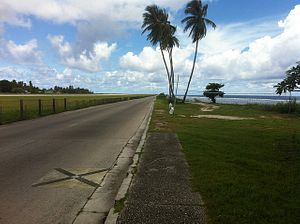The South Pacific island of Nauru is the third smallest state in the world, behind the Vatican and Monaco. It has a territory of just 21 square kilometers (8 sq miles), with a population of around 10,000 people. At present the country has very few resources. However, for a period in the 1970s and early-1980s Nauru was the one of the wealthiest countries in the world. At one stage the island was deemed to have the world’s second largest GDP per capita.
Nauru’s wealth came from island’s high quality deposits of phosphate, which are an essential component in agricultural fertilizers, and also used in explosives. However, the finite nature of the country’s phosphate deposits, combined with chronic mismanagement of the wealth it generated, has led to a dramatic fall in Nauru’s fortunes.
Today, Nauru’s GDP per capita ranks 195th in the world, and unemployment on the island is at 90 percent. Phosphate mining has ruined any arable agricultural land the island had, and its ability to sustain any other viable industries (the island tried a brief flirtation with international money laundering). The lack of agricultural resources on the island has led to the population existing on a diet of imported processed foods, resulting in 94 percent of the adult population being deemed “overweight” by the World Health Organisation. Rates of diabetes and cardiovascular disease are extremely high.
The negative effects that phosphate mining would have on the island were recognized as far back as the 1960s. At the time, the Australian government — realizing that the island would become uninhabitable — appointed a Director of Nauruan Resettlement to search for a potential location to relocate the Nauruan people. The idea of resettlement arose again in the early-2000s, but issues of maintaining sovereignty and cultural identity have prevented any scheme from coming to fruition.
Nowadays the country’s main sources of employment, for the 10 percent of the working age population who are employed, are the aid-reliant public sector, and the detention center the island hosts for people seeking asylum in Australia. However, it is this detention center, officially known as the Regional Processing Center (RPC), that is causing the latest problems in Nauru’s messy modern history.
The Australian government’s policy is that no person seeking asylum via a maritime route will ever be settled in Australia, regardless of whether they are found to be genuine refugees. Those who have attempted to reach Australia by boat have been transported to detention centers either on Manus Island in Papua New Guinea (recently ruled unconstitutional by the PNG Supreme Court) or on Nauru.
Australia saw the offshore detention center on Nauru as a way to kill three birds with one stone. It could solve a domestic political problem of public suspicion towards refugees, it could disrupt people smugglers who could no longer claim their services would get asylum seekers to Australia, and it could also provide Nauru with a new source of income to prevent it from becoming a potential failed state.
As a result Nauru’s national interest has became reliant on a steady stream of asylum seekers to maintain the continued existence of the detention center. However, with Australia having “smashed the business model” of the people smugglers, they have left Nauru without a continued supply of “product” to warehouse. The second part of Australia’s plan undermines the third.
Due to Nauru’s need to protect the offshore detention scheme the barriers it has set to investigate the conditions in the RPC have been raised. In 2014, the fee for a journalist visa to the country increased from US $180 to US $7000. The fee is non-refundable should the application be unsuccessful, effectively signalling that the country is off-limits. When media outlets such as the Australian Broadcasting Corporation (ABC) report on conditions for refugees on Nauru (using covert tactics), the response from the Nauruan government is highly defensive.
As of August this year there are 410 people being held in the RPC, with around 700 others, whose refugee status has been confirmed, living in the wider Nauru community. However, with almost no employment prospects and a public increasingly hostile to their presence, alongside the country’s aforementioned structural problems, Nauru lacks the resources to be considered a genuine resettlement location for these people. Yet, the Australian government refuses to resettle refugees in countries that are suitably well-resourced, seeing this as a “marketing opportunity” for people smugglers.
Maintaining this posture presently seems essential for Australia’s business model in its arc of instability. However, while the current policy stalemate might temporarily suit both parties’ perceived interests, the conditions required to maintain it are unsustainable. Those refugees and asylum seekers currently on the island are unfortunate pawns in an attempt to stave off an inevitable decision about the country’s future viability.
Due to its current lack of resources, Nauru has been left with little choice but to sell its sovereignty to Australia. However, as with the country’s phosphate mining, the short-term nature of this sale is becoming apparent. The brutal irony is that without the current presence of displaced persons, the people of Nauru may become displaced themselves.

































